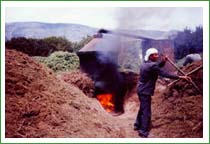the majority component of the essential oil of rosemary
of Tunisia is the cinéole 1,8 (eucalyptole).It is mainly accompanied by a and ß pinenes, camphene and camphor.
This chemical composition is
standardized (AFNOR) as follows :
a pippin
:9 to 14%, camphene 2,5
to 6%
ß pippin : 4 to 9%, myrcéne 1 to 2%
momene : 1,8 to 4% cineol 1,8%: 38 to 55%
p.cymène :0,8% to 2,2% camphor: 5 to 15%
acetate of bornyl : 0,1 to 1,6%
a terpineol : 1 to 2,6%, bornéol : 1,5 to 5%
verbénone : 0,0
to 0,4%
Of other components can be detected among which : terpenic
hydrocarbons (tricyclene,
a fenchene,
sapience, 3caréne,
a paradiméthyl styrene,
a phellanciéne,
a terpinéne., cis and trans octmene,
terpinolene) and sesquiterpenic (a
humulene,
a
ylangene, ß
ß caryophylene,
a
copaene, germacrene D, d cadinene) as well as
oxygenated derivatives, octene -1, ol-3, octanone-3, finalol, isopulégol,
pinocamphone, tepinéne 4ol, myrténal, acetate isopulégol,
pinocamphone, tepinéne 4ol, myrténal, acetate isobornyle, oxide of
caryophylene.
